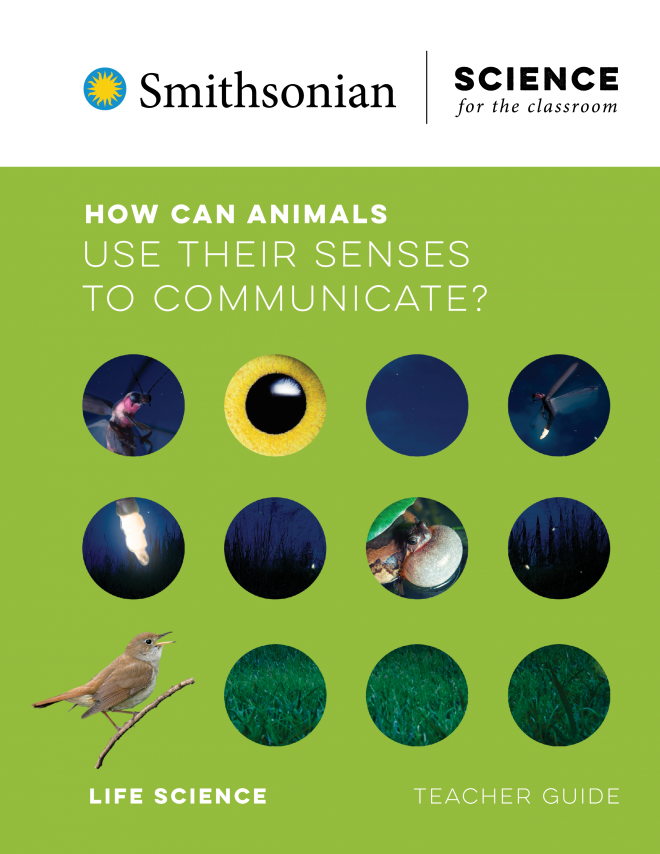How Can Animals Use their Senses to Communicate?
How Can Animals Use their Senses to Communicate?
How Can Animals Use their Senses to Communicate? is part of Smithsonian Science for the Classroom, a brand new curriculum series by the Smithsonian Science Education Center. It is aligned to a group of grade 4 standards. It has a focus on life science with a secondary focus on physical science and engineering. In this module, students:
- Analyze structures that support animals’ senses and investigate how light travels when they see an object
- Investigate how information is processed in the brain and analyze data to determine how memories can affect behaviors
- Carry out an investigation into whether fiddler crabs wave more often when there are other crabs present and analyze the system in terms of sender, signal, and receiver
- Design and test a method for sending information about a picture using 1s and 0s and short and long flashes of light
- Construct an argument based on testing with models for which firefly flash patterns are the most effective for communicating to find a mate
Below are digital resources that support teaching of this module.
Animal Communication
This video of animals communicating introduces the phenomenon for the module.
Download the Animal Communication Video
Download the Accessible Version of the Animal Communication Video
Download the Animal Communication Video Transcript
Using Reflectors in Photography
These images show similar photos taken with and without use of reflectors.
Download the Using Reflectors in Photography PDF
Human Eye
This image can be used in lieu of looking at another student’s eyes.
Download the Human Eye PDF
Survival Sense Argumentation
This file has images and information about the star-nosed mole and tarsier.
Download the Survival Sense Argumentation PDF
Human Nervous System
This file shows the human nervous system and visual system.
Download the Human Nervous System PDF
Firebug Study
This file compares the human and bird nervous systems and introduces the animals in the firebug study.
Download the Firebug PDF
Warning Coloration
This file shows a variety of animals with red-orange and black warning coloration.
Download the Warning Coloration PDF
Fiddler Crabs Waving
This video shows wild and captive fiddler crab males waving their oversized claws to communicate.
Download the Fiddler Crabs Waving Video
Download the Accessible Version of the Fiddler Crabs Waving Video
Download the Fiddler Crabs Waving Video Transcript
Defining Communication
This file shows a possible definition for communication.
Download the Defining Communication PDF
Plant Structures and Pollination
This file shows the basics of plant structures and the process of pollination.
Download the Plant Structures and Pollination PDF
Traffic Noise
This file shows noisy traffic (only the audio is needed for the lesson).
Download the Traffic Noise Video
Download the Accessible Version of the Traffic Noise Video
Download the Traffic Noise Video Transcript
Nightingale Song
This video shows a nightingale singing.
Download the Nightingale Song Video
Download the Accessible Version of the Nightingale Song Video
Download the Nightingale Song Video Transcript
Nightingale Research
This file introduces the nightingale song study.
Download the Nightingale Reserch PDF
What’s the Code?
This file shows digital images and introduces the problem for the lesson.
Download the What's the Code? PDF
Color Picture
This file shows a color picture that students can develop a code for.
Download the Color Picture PDF
Lifeguard Communication Problem
This file introduces the lifeguard communication problem.
Download the Lifeguard Communication Problem PDF
Telegraph SOS
This video shows a telegraph key messaging SOS in Morse code.
Download the Telegraph SOS Video
Download the Accessible Version of the Telegraph SOS Video
Download the Telegraph SOS Video Transcript
Flashing Fireflies
This video shows fireflies flashing using bioluminescence and introduces students to the phenomenon for the Science Challenge.
Download the Flashing Fireflies Video
Download the Accessible Version of the Flashing Fireflies Video
Download the Flashing Fireflies Video Transcript
Sample Flash Pattern
This file shows an example of a visual model for a simplified firefly flash pattern.
Download the Sample Flash Pattern PDF
Firefly Communication Testing
This file shows the procedure for testing the flash patterns with physical models.
Download the Firefly Communication Testing PDF
Lights at Night
This link has information about sources of light pollution and how to prevent it.
https://darksky.org/light-pollution/




Kit Tips & Tricks